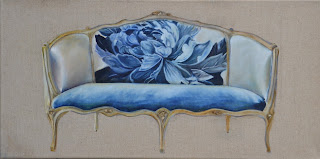When collecting art means to
commit leadership, as we said in part 1 of this essay, then it needs pathfinders,
who are scouting the collector and his financial advisors through the jungle of
offers in the art-world. Bankers and
wealth managers are often don’t know quality criteria of artwork as well they don’t
learn the key pillars of art-investment at the universities, so from time to
time they consider that there aren’t any quality criteria and possibilities to
minimize the risk. This makes art suspicious and risky. They let the expertise
up to art-historians, who find themselves in a responsibility for art-investments
which is not theirs. This miss-understanding excludes potential investors and
buyers from the art-sector. Now I am talking about people who have the financial
freedom to buy art, which doesn’t mean that they have millions of dollars. This harms the role of art in asset-management
and makes it smaller than necessary.
It is astonishing, because
collecting art is one of a few investment possibilities, where the investor can
reduce the risk and improve his chances for profit, directly by himself.
Provided that he selected an artist to support, with support of an art-advisor
for example, he can also take a look on the career-chance of the artist. This
is more than a simple speculation. It means analyzes of the artist,
artistically as well as the character of the personality. For example committing
to the career of young painter from South-Eastern-Europe can be a promising investment.
The investment might be in buying three artworks. Now starts the work to
minimize the risk. Usually, the collector can discuss with friends, contacts,
galleries etc. to organize interesting exhibition or sales possibilities for
the artist. This is task of the Gallery representing the painter, but it is in
the interest of the collector to enforce this activities. Both have to work
here hand in hand. With some good contacts
by the collector it is possible to increase the value.
Let’s say, I discover an artist
and follow his work and his development for a certain period. Then I bought
three of his works in a total amount of 10.000 Euro. With the knowledge about
the artist and his work, with my personal contact to the artist I can commit
myself. This means now starts the responsibility of the collector and I start
to promote the artist in my professional and private network. Being a Maecenas has
a strong philanthropic aspect, but this commitment for the artist can be a
typical win-win situation for all sides, the artist and his gallery on one
side, me as a collector and my art-advisor on the other side. After a while of
some work for all of us, the price might be now for one work at 7.000 - 10.000
Euro. Selling one work will lead to the situation, that me as a collector
received two works (almost) for free. Then I can consider to continue the game
and sell one more later, or I donate one work of my artist to a meaningful
museum, in order to increase the name, reputation and value of my collection.
By the way, with every exhibition, the reputation and value of my collection
will increase.
Different is the situation investing
in Blue Chip artworks. If a collector or a group of investors buys a relevant
work by a namely master, the idea is very simple, to buy cheap and sell
expensive on an auction. This might be a possibility for artists who are
established on the auction markets already. Me personally I find the developing
of upcoming and emerging artists more exciting. And this you can start
sometimes with astonishing small budgets already, in spite they are highly promising. Simply spoken, the profit rate is higher, while investing in upcoming artists from Central and Eastern Europe.
Of course all these above
mentioned possibilities are easier for experienced collectors with contacts who
are for several years in the business. But even newcomers can enter into the
game. Here as well the scouting of an art-advisor or a wealth manager can be
helpful.
The questions bankers are often
asking “What to do when you need the liquidity back and have to sell art?”
Everyone has in mind to be forced to bring the works to an auction-house, where
they are sold by any price, even below. This thinking is coming when the
difference between price and value of artworks is not known. Investing in real estate seems to be easy,
because it is about figures and stones. Investing in art means it is about
investing in the personality of the artist. The freedom of the artists can
scare mathematicians and hold them back from investment-proposals. But
investing in art is one of the safest and most transparent real asset
investments, especially in times of crisis and post-crisis. The art-market is
transparent, just some knowledge about the rules is required, but this know-how
you can learn or buy. At the end of the line, every business has its rules.










